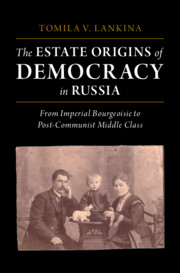Book contents
- Reviews
- The Estate Origins of Democracy in Russia
- The Estate Origins of Democracy in Russia
- Copyright page
- Dedication
- Contents
- Figures
- Tables
- Preface
- Notes on Transliteration
- Abbreviations
- Dramatis Personae
- 1 Theorizing Post-Revolutionary Social Resilience
- 2 From Imperial Estates to Estatist Society
- 3 Mapping Society and the Public Sphere in Imperial Russia
- 4 The Professions in the Making of Estatist Society
- 5 Education, Socialization, and Social Structure
- 6 Market Values and the Economy of Survival
- 7 Family Matters: Looking Back – and Forward – in Time
- 8 Society in Space
- 9 The Two-Pronged Middle Class: Implications for Democracy across Time and in Space
- 10 The Bourgeoisie in Communist States: Comparative Insights
- Afterword
- Supplementary Appendices
- Bibliography
- Index
3 - Mapping Society and the Public Sphere in Imperial Russia
Published online by Cambridge University Press: 02 December 2021
- Reviews
- The Estate Origins of Democracy in Russia
- The Estate Origins of Democracy in Russia
- Copyright page
- Dedication
- Contents
- Figures
- Tables
- Preface
- Notes on Transliteration
- Abbreviations
- Dramatis Personae
- 1 Theorizing Post-Revolutionary Social Resilience
- 2 From Imperial Estates to Estatist Society
- 3 Mapping Society and the Public Sphere in Imperial Russia
- 4 The Professions in the Making of Estatist Society
- 5 Education, Socialization, and Social Structure
- 6 Market Values and the Economy of Survival
- 7 Family Matters: Looking Back – and Forward – in Time
- 8 Society in Space
- 9 The Two-Pronged Middle Class: Implications for Democracy across Time and in Space
- 10 The Bourgeoisie in Communist States: Comparative Insights
- Afterword
- Supplementary Appendices
- Bibliography
- Index
Summary
This chapter demonstrates that, before the Revolution, Russia had a vibrant public sphere. The institutionalization of society into dense webs of autonomous or semi-autonomous public and private institutions followed the contours of society. One’s estate continued to matter in the consolidation or extension of social networks. The Bolsheviks decimated segments of the state apparatus, but a large chunk of the autonomous, highly networked, and enterprising society survived the Revolution. The dense ties linking professional organizations like schools, hospitals, and the civic arena, and embracing museums, historical conservation bureaus, and archaeological interest groups, helped cushion and eventually catapult segments of the estatist bourgeoisie into the elite or otherwise comfortably well-off “intelligentsia” substratum of Soviet society. The autonomous agency of these institutions, and of the actors embedded within them, nurtured its own tensions, evasions, and complications in dealing with the Tsarist state and facilitated adaptation and survival under the new regime, something that I conceptualize as one element of the democratic legacy of the educated estates. The chapter describes the social character of the urban bourgeoisie in late imperial Samara; performs systematic social network analysis employing material from pre-revolutionary directories of the white-collar strata and civil society; and provides an account of the bourgeoisie’s post-revolutionary adaptation.
- Type
- Chapter
- Information
- The Estate Origins of Democracy in RussiaFrom Imperial Bourgeoisie to Post-Communist Middle Class, pp. 82 - 121Publisher: Cambridge University PressPrint publication year: 2021

